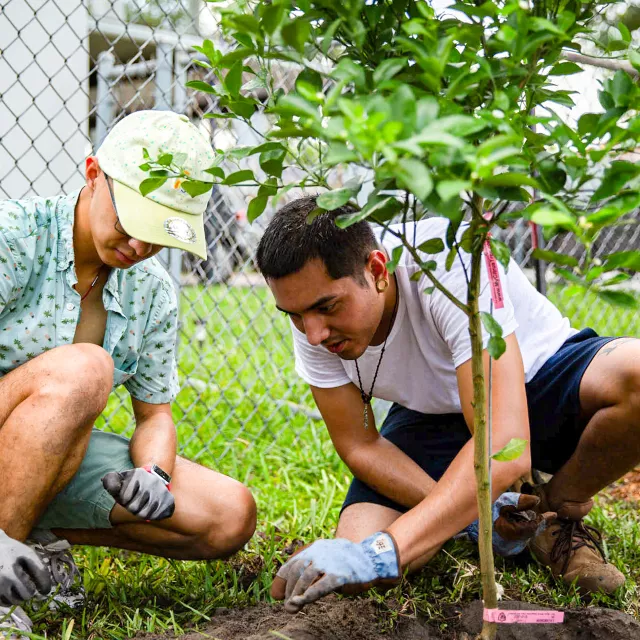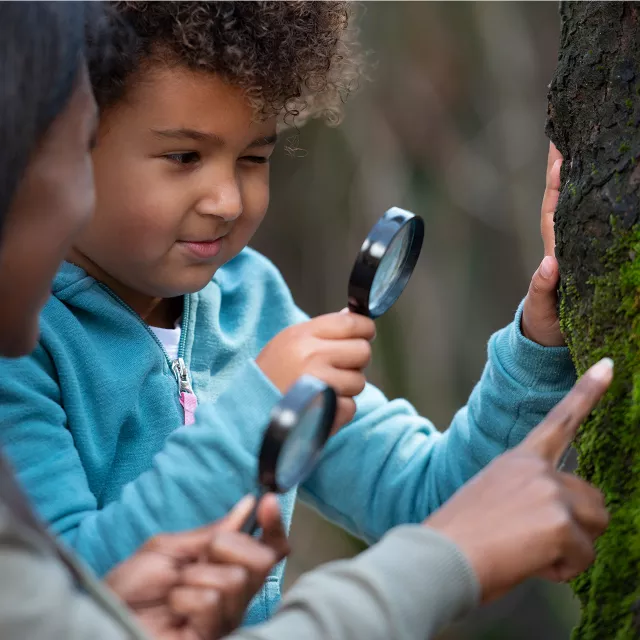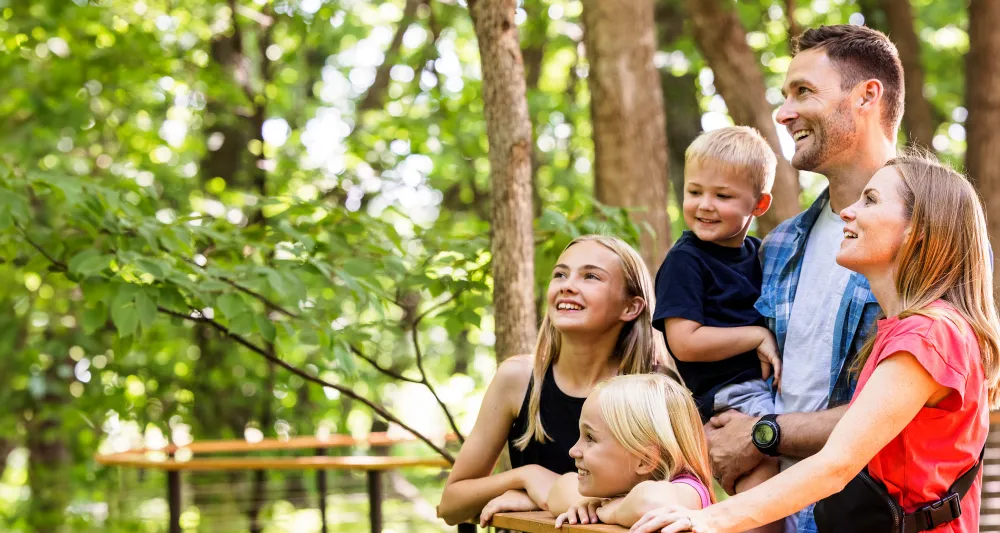
Find out more about how you can celebrate trees this Arbor Day, whether it’s planting a tree or planning a large-scale, community-wide event.
Find Celebration Materials
This year, plan to celebrate Arbor Day in a big way! Let us help you get everything you need—tree seedlings, quotes, music, an official proclamation and more—for a successful event.
Event planning materials
It’s never too early to start getting organized, and we’re here to help.
Tree Planting Instructions
Planting a tree is much more than merely digging a hole. Be sure to select a good planting site, select the right tree and follow planting instructions for the type of tree you are planting.
Identify the prospective tree planting location and, if it is on city property, find out what municipal department is in charge of planting and caring for city trees. Ask that department who is responsible for the identified area and what process must be followed to receive permission to plant a tree there.
When choosing a location, keep in mind soil conditions water availability, overhead wires, space available for roots (to avoid upsetting sidewalks or streets) and space available for the canopy (to avoid interfering with traffic or business signage).
When selecting a tree to plant, be sure to consider what the tree needs and what the planting site can provide. There are six ''tree needs" to compare with the site’s conditions:
- Temperature – Trees have a limit to the cold they can endure. Check hardiness zones before choosing a tree.
- Moisture – Each species can tolerate wet or dry conditions to a different degree.
- Light – "Shade tolerance" is the term foresters use to rate the light requirements of each species.
- Pests – Every locality has problems with a particular insect or disease. Some trees are more susceptible to a certain disease than others.
- Soil – Soil depth, structure, pH and moisture can make the difference between success and failure with a tree. Each species has its preferences.
- Air pollutants – Chemicals in the air vary with localities; some trees are more tolerant of air pollution than others.
Before you make the final decision on the tree species, other factors should be considered. Is the tree being planted to save energy and provide shade? Is it being planted to beautify the grounds? Is providing wildlife habitat important? Will the tree be part of a windbreak or shelterbelt? Determining why a tree is being planted will help identify the ideal species.
Also know how big it will be at maturity. Will it have "head space" and root area to grow well? Will roots interfere with the sidewalk, patio, or driveway at maturity? Will it block windows or scenic views or tangle with the utility wires when it is mature? These answers will all help eliminate inappropriate species.
Finally, keep in mind its shape, its leaves and its impact on the area.
After you have chosen a tree that is suitable for the location, get permission to plant from the appropriate city agency. Have your choice approved by your city or state forester.
Get planting instructions based on the root configuration of your tree:

Community Tree Contest
Design an activity that engages students in identifying and measuring trees in their community, integrating science and math skills. Teachers should guide students through selecting trees, measuring circumference, height, and crown spread, and understanding the significance of different tree species. Whether as part of Arbor Day or a stand-alone project, this experience promotes hands-on learning and fosters environmental stewardship.
Celebration Ideas
Find inspiration and suggestions for your own celebration — whether for a classroom or an entire community.
Hold an Arbor Day ceremony and honor the good stewards in your community.
Choose people who have made a difference by advocating for or accomplishing something environmentally significant within your community. Consider honoring people who have initiated or completed projects like establishing a tree planting or recycling program; identifying or planting an arboretum; or raising funds and getting permission for an outdoor learning center. If possible, seek nominations from the community.
Organize a Big Tree or Oldest Tree search within your community.
Once the results are in, publish a booklet with a map that lists the locations of the winners, label the winners that are in public places or provide a walking tour of the winners. Trees of historical significance to the community could also be added to the tour.
Plant a tree.
Be sure to choose the right tree for the right place and correctly plant and care for it. Ask members of the planting committee to sign a pledge to care for the tree and bury it in a time capsule near the tree. Take a photo of the planting crew and send it to the local newspaper to tell everyone about the significance of the new tree.
Host a reception to honor the Tree Board members in your community.
Invite representatives from city agencies as well as the community at large. Plant a tree at City Hall and have the Mayor issue an Arbor Day Proclamation. Local school children can read poems about trees, and refreshments can be served. If your community is a designated Tree City USA, the reception should honor this accomplishment. If not, work with your city or state forester to make your community a Tree City USA.
Write a story, produce a play, or present a skit about trees.
A good choice for an Arbor Day play is Trees: A Joy Forever. Remember the older residents in nursing homes and retirement villages. They may have some Arbor Day stories to share and are usually a very appreciative audience. Day care centers are also very receptive to special programs.
Choose a public park or downtown area to clean up.
Recycle what you can and dispose of the rest properly. Ask residents within the area to help with the cleanup and encourage everyone to maintain the area once the work is done. Sign a park care pledge and post it in the park shelter or on a bulletin board in a city building. Plant trees, flowers, and shrubs to beautify the area even more.
Read a book about trees.
Learn to identify the trees in your yard by their leaves, bark and seeds. Our tree identification field guide is a great place to start. See what animals, birds and insects live in and around a tree. Lie down on the ground and look up through the branches, noticing the light pattern created by the branches and leaves. Create a bark rubbing using paper and a crayon. Join the Arbor Day Foundation and help plant trees in our nation’s forests and in your yard.
Hold an Arbor Day Birthday Party for the community.
Read an Arbor Day Proclamation, plant a tree and serve cake and ice cream. As guests leave, hand out tree seedlings or a coupon from a neighborhood nursery.
Sponsor a craft show featuring exhibitors who engage in crafts with natural materials.
Woodcarving, pottery, dried flower arrangements, cornhusk dolls, pinecone wreaths and pressed flowers are just a few examples. Cooking demonstrations could also be held using products derived from trees. Recipes that include apples, nuts or chocolate are among favorites. Make sure you provide samples for the audience!
Schedule classes on tree pruning, tree selection, tree identification and tree planting.
Charge a small registration fee and use the money to purchase tree seedlings for the participants, or buy one larger tree to plant on public property in honor of those attending the class.
Hold a Read-In at the library.
Have all available books about trees—both fiction and nonfiction—on display. Story time for younger children can feature tree-related books. This is a great way to increase awareness of the tree resources available at your library.
Host a concert.
Compile a playlist of songs about trees or that include tree names in their titles.
Sponsor a poster contest, poetry contest or tree trivia contest.
Give trees away as prizes.
Organize a tree identification hike.
This could take place in a park, at a nearby forest or along the streets of the community. Ask girl scouts and boy scouts to serve as guides.
Volunteer with a local tree-planting organization.
It’s a great opportunity to meet new people and make a difference in your community.
Encourage neighborhood organizations to hold Arbor Day block parties.
It’s a good way to get attendees excited about caring for the street trees in front of their homes and planting more trees in their yards. Buttons and tree seedlings make great giveaways at these events.
Additional Resources
Looking for more information about trees?



